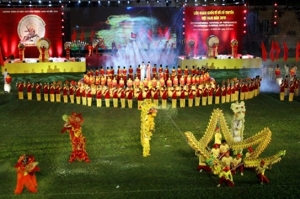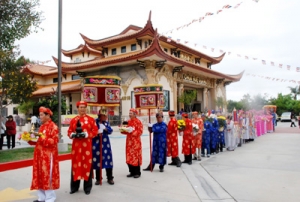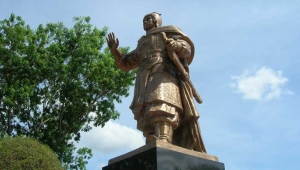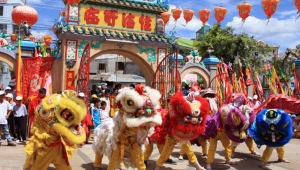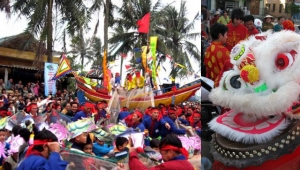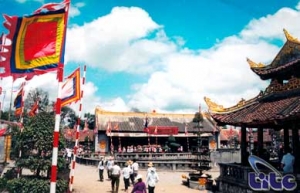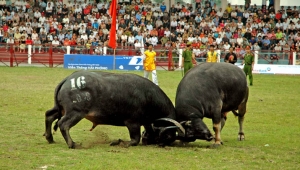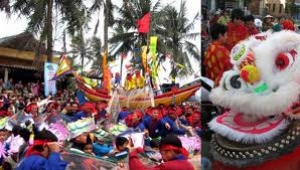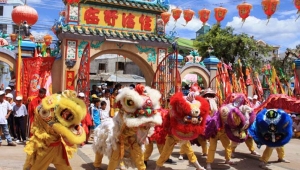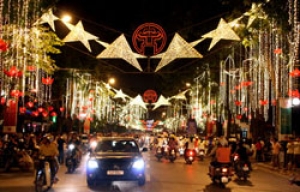
Asia Pacific Travel Team
Vietnamese Traditional Martial Arts Festival
The three-day Vietnamese traditional martial arts festival in central Binh Dinh Province, father land of the “Viet Vo Dao”, is not only a way to popularize the Viet’s martial arts, but also a reflection of its prestige in the world.
Vietnamesetraditional martial arts have been learnt in 100 countries andterritories by hundreds of thousands of followers. It is now one of theworld’s most popular sports.
Central Binh Dinh Province is the cradle of Vietnam’s martial arts andrecognised as the birthplace of traditional martial arts in Vietnamfrom the time of the Tay Son-Binh Dinh martial arts school in the 18thcentury. It has proudly continued the tradition of producing some ofthe country’s best talent in the discipline.
The traditional martial arts festivalbegins with performances at Quy Nhon Town, the capital of Binh Dinh,and surrounding areas including King Quang Trung Museum, Hoang De(Emperor) Citadel and Nhon Hoi Economic Zone – which is symbolic ofcentral Vietnam’s economic development.
“Viet VoDao”
“Viet VoDao”, based on the principle of harmony between hard and soft, was founded by grandmaster Nguyen Loc less than a hundred years ago during French colonization in Vietnam. Mr. Loc developed the martial arts mainly for self defense that uses force and reaction of the opponent to fight against him.
“Viet VoDao”is not just a way for health training, moral refinement, human sense ofloving, but the martial arts also reflects the generosity of a heroicand sporting people.Vietnamese traditional martial arts attracted people of all generation to train. “Viet VoDao”techniques invovle kicks, throws, escape and levering, wrestling,punching, kicking, and even employ swords, sticks, and knives.
The founder Truong Thanh Dangspent his whole life to understand, practice, research and consolidatethe cultural heritage and the martial arts treasure into a unique,creative system.
Spectacular martial arts displays
Withthe will of a free independent country and their invincible patriotism, the Vietnamese have developed a strongfighting spirit, which can be seen in the decisive wars : "To escape from the humiliating misery and hardships of slavery. They have to win the enemies"
TheVietnamese traditional martial arts which is very rich informs, was developed based on the bloody experiences acquiredduring the courageous fights to protect their country and people .
BinhDinh Province is famous for Vo Tay Son, also known as Vo Binh Dinh, anancient martial art that was developed in the area. Ten out of 11districts in the province have established martial arts trainingcentres with nearly 100 clubs. The provincial traditional martial artsassociation manages 80 masters and attracts approximately 1,000students in regular training courses.
Comingto Binh Dinh and attending the festival, you can join local teams andwitness the showcase for their talent in martial arts, as well as BinhDinh’s scenic beauty and distinctive, appealing culture. Participantsdemonstrated their various performances at the villages, allowingeveryone to imbibe the unique aspects of martial arts in differentcultures.
Moreover,the participants can also visit the province’s martial arts villagessuch as An Thai and An Vinh, where they can learn about thetime-honored arts from successors of martial arts forefathers. Thefestival features enthralling events including battle drumming,international martial arts competitions and a beauty pageant with someof Vietnam’s most dangerous women.
Battle drum
TaySon battle drumming has always been close to locals hearts. It is saidthat during battle, Nguyen Hue, who later became Emperor Quang Trung,used a 12 drum system, which symbolized Asia’s 12 zodiac signs, to give battle commands, boosthis soldiers’ morale and convert his enemies to good causes. symbolized Asia’s 12 zodiac signs, to give battle commands, boosthis soldiers’ morale and convert his enemies to good causes.

Accordingto Tran Dinh Ky, director of King Quang Trung museum in Quy Nhon Town,Tay Son battle drumming is a special genre which blends military andartistic elements and is based on the traditional sound systems such asho, xang and xe.
It is extremely difficult to express the “soul” of Tay Son battle drumming, which explains why few artists can perform it well.
Amember of the King Quang Trung museum’s martial music troupe, HoangMai, a girl in her early twenties, has been selected as the mainfestival drummer and an icon to popularize the genre.
Beauty pageant
Inthe festival, beauties from martial arts schools in almost 40 countriesparticipate in a beauty pageant titled “Hoa hau nhung mien dat vo”(Beauties from the Lands of Martial Arts).
“Femalegeneral Bui Thi Xuan, one of the leading figures in the Tay Sonuprising who possessed both charms and great martial art skills, waschosen as the image of the contest,” a member of the organizing boardsaid. “The contestants not only compete in physical attractiveness;they also show off their mental and physical strength by displayingtheir martial arts skills,” he added.
Tuong(Vietnamese classical drama) and particularly tuong from the province’sDao Tan tuong theater, one of Vietnam’s tuong cradles, is also a partof the contest. In Binh Dinh tuong and martial arts share some of thesame movements giving them a close connection.
Other highlights
Thefestival begins with a procession and flower offering, at King QuangTrung museum at 8 a.m, to honor Emperor Quang Trung, a shrewd king anda great national hero.
Onthe next day, tourists can ride in 22 sailboats, which symbolize 22years of “doi moi” (economic reform), and let loose flower garlands andcolored lanterns at Thi Nai Bay and Thi Nai Bridge.
Thereis also superb fireworks shows and traditional musical performances bylocal and international artists throughout the festival.
Another highlight is a traditional handicraft fair, with many stalls at the central park in Quy Nhon Town.
Visitorscan also relish specialties such as the very strong Bau Da wine and PhuMy nem (fermented pork roll) at the fair. An ornamental plant fair andcompetition featuring a wide variety of rare plants and bonsai fromacross the country is organized at the province’s Labor Cultural House.
Impression on the first national martial arts festival
The first national martial arts festival was held in Binh Dinh in 2006. Many domestic and foreign-based masters of “Viet VoDao” togetherwith some 500 other enthusiasts across the world have come to thefestival to take part in the return to the sport’s ancestral land toattending the first “Viet VoDao” festival.
Phan Tho, a “Viet VoDao”master permanently living in Binh Dinh, expressed that he feelssatisfied to see the festival held in his homeland. He said this is hisbiggest happiness after spending some 70 years of training “Viet VoDao”.
Many other “Viet VoDao” masters as Tran Tien and Ho Hoa Hue and foreign-based masters are pleased with the festival.
Thenumber of delegations and artists to join the year 2007’s festivalalmost doubles the year 2006’s numbers, which means traditionalVietnamese martial arts have grown in stature on the world scene...
“Mua Vu Lan” – Mother’s Day in Vietnam
Westerners have Mothers’ Day to be proud of, the Vietnamese treasure their seventh full moon of lunar calendar ("Mua Vu Lan") as a time to express filial piety to their parents, especially their gratefulness and appreciation to their mother.
Annually, Vietnamese children honor their parents and try to help the lost souls of their ancestors find their way back to earth.
“MuaVu Lan” is closely connected to the Asian tradition of ancestor worshipand filial piety. It is also known as the Buddhist holiday, atraditional event in praise of motherly love held solemnly once a yearin Vietnam.
What does the legend really mean?
Thelegend behind the festival dates back to the earliest of Buddhism. Oneday when he was meditating, Muc Kien Lien, one of the Buddha's tenprinciple disciples, saw his late mother suffering the tortures ofhell, condemned because of the evil deeds she had committed during herlife.
Hesaw that his mother was starving, but she had nothing to eat but fire.Muc Kien Lien summoned all his spiritual powers to bring her a bowl ofrice - but the food was burnt to ash before she could bring it to hermouth.
Whenhe arrived back in the physical world, he asked for the Buddha’sguidance to help his mother and fulfill his duty as a pious son. TheBuddha advised him to collect a gathering of monks and devotees and getthem to pray together on this day (which this year falls on August 15in the Western calendar).
Thecombined prayers proved to be so powerful that they achieved therelease not only of Muc Kien Lien’s mother, but also for countlessother souls. Ever since, on the festival of Vu Lan - Wandering Soul’sDay- the gates of hell are believed to be thrown open to give thetormented souls 24 hour holiday.
A solemn sharing
“MuaVu Lan” is believed to be the spirit month in Vietnamese culture as away of honoring the dead. On this day, souls are believed to return totheir former homes.
Fromthis assembly, many Buddhist countries developed the custom of offeringfood, clothing and other items to hungry spirits in the month when therealms of Heaven, Hell and the living are open.
Theobject of this ceremony is to feed the hungry ghosts and to pray fortheir salvation. This ceremony is a way for people to meet theircompassionate filial duty. During the ceremony, offerings are made torescue up to seven generations of ancestors from whatever misery theymight be suffering. During the month, every family can choose a day topresent a feast and burn joss paper and incense in front of the houseto invite the spirits to eat.
Themost distinguished feature of the ceremony is the “offering snatching.”After the incense burns down, the neighborhood children are allowed tograb the food. No one will stop them as it is believed the spirits maybe angered if they do so. The ceremony is also a great chance forpeople to express their gratitude to their parents.
Onemore tradition of this day is for people – Buddhists and non-Buddhistsalike – who wish to express their gratefulness and appreciation towardstheir mothers, to go to a pagoda, often wearing a rose. Thousands ofpeople flock to pagodas wearing red roses if their parents are alive orwhite roses if their parents have passed away. The rose has been asymbol of love and sharing among parents and their children regardlessof social background.

Modern view
“Thisfestival is a chance for guilty homeless spirits to be pardoned. Peopleworship ghosts and release animals, such as birds or fish,” said MyNgoc, a university student living in Tan Binh District, Ho Chi MinhCity. I am going to the pagoda this year to pray for my mother becausewe are miles apart. My mother is living in my hometown in the centralprovince of Binh Dinh. I always think of her,” Ngoc said.
“Althoughnowadays the youth live faster and are becoming more unfamiliar withtraditional values, they still deeply love and respect their parents,”visitor Duc Phong said as he strolled around Vinh Nghiem Pagoda, themost famous Buddhist temple in Ho Chi Minh City. “That’s why manyyoungsters visit pagodas and present their parents with flowers on thisday,” Phong said.
VisitorMinh Thuan said: “The festival is no longer exclusively for Buddhistsbut an occasion for everyone to express their love to their parents.This cultural trait has not faded over time but become more and morediversified.”
The diversity of “Mua Vu Lan” can be seen throughout the country with many different activities.
Dong Da Festival - Hanoi, Vietnam
Dong Da Festival, Vietnam festivals: Dong Da hillock festival takes place annually on the 5th of Lunar New Year. This is a victorious festival, organized in memory of the King Quang Trung's great merit - the hero in national history of anti - invaders.
Two centuries ago, Dong Da was a battlefield where Quang Trung (Nguyen Hue), a Tay Son farmer who later became a National Hero defeated more than 200,000 soldiers of the Qing invading army. Dong Da Hill became a glorious historical site of the Vietnamese nation.
In the early morning of the 5th day, a procession for the historical event's celebration commences at Khuong Thuong and ends at Dong Da Hill. The procession includes flags, a processional parasol, palanquins with a variety of colours, and the sounds of gongs and drums.
In the festival there are a lot of games representing martial spirit. Among them, the procession of Thang Long dragon is most original.
Khuong Thuong village communal house's gate is opened at the first gleam of daylight with pervasive fragrance of joss - stick. In front of the house, a big flag is hung to welcome the festival.
More than 200 years ago (1789) this was a bloody battlefield. In the small hours of the 5th of Ky Dau Lunar New Year (on the 29til and 30'1' of the 2nd month 1789). the camp of invaders in Khuong Thuong was destroyed, the invader. Ethnarch Dien Chau Sam Nghi Dong had to commit suicide here. Since then, Dong Da hillock became a famous relic of our people. It is also an evidence of shameful failure of the Northern enemies.
In the morning of the festival, all dignitaries and elders in the village gather fully to prepare for the great ceremony. Nearly 12 o'clock at the noon, from Khuong Thuong communal house to Dong Da hillock, everybody implement the procession of greeting the victory. The procession is long, beautiful. It moves slowly and orderly for people to revere detailedly the magnificent statue of the festival.
But the most attractive and youngest is the last group with "Fire Dragon". Young men in two villages Dong Quang and Khuong Thuong emulate to plait straw into shapes of big dragons ornamented by spathe and papier mache. A band of young people in uniform go around the procession of Fire Dragon and perform stick and fist with the aim at reappearing images of former battle and glorifing Tay Son righteous armier's buoyancy. This is an original amusement of Dong Da hillock festival.
Since the capital was liberated (October, 10th, 1954), Dong Da hillock festival has been regared as a traditional one - a national festival. Thus, every year, leaders of Party and State come to attend and preside at all rites of the festival. The national flag and flags of the festival fly flutteredly as greeting pilgrims. Oppositing the hillock is Dong Quang pagoda where smoke of joss - stick also spreads out and visitors go in and out plentifully. Here, priests make rice gruel for invaders1 spiritualists as a righteous action of our traditional virtue. People also offer flowers to celebrate in front of the King Quang Trung's statue.
After solemn rites are games and traditional art activities such as unicorn dancing, dragon dancing, wrestling, human chess, cock fighting... The home of the King Quang Trung - Nguyen Hue is Binh Khe district, Binh Dinh province. Here, people also build a temple for three brothers of Tay Son family to be Nguyen Nhac, Nguyen Hue and Nguyen Lu. Every year, also on the 5th of Lunar New Year, everybody from everywhere come to offer flowers and joss -sticks to represent their gratitude to heroes and righteous men and review glorious and pround history of our country. They also hold competitions of military or beating drums... very distinctively. Especially, participants are not only men but also women, so it attracts more and more visitors.
Nowadays, for Ha Noi people, visiting Dong Da hillock festival has become an indispensable need an early spring.
Phan Thiet's Nghinh Ong - Quang Thanh Festival Has a Spectacular Start
Yesterday kicked off Phan Thiet's 3-day Nghinh Ong - Quang Thanh Festival. The festival combines the local fisherman's whale worship religion with Chinese Taoism and Vietnamese Buddhist practices into one of Vietnam's most spectacular spectacles.
Absolutely amazing martial arts performances.
Cau Ngu Festival in Vietnam
Cau Ngu festival in Vietnam, which is also called Whale festival, is the biggest festival of the fishermen in Da Nang Province in Vietnam.
Objects of worship: Truong Thieu (Quy Cong - the founder of the practice of fishing)
Time: The 12th day of the first lunar month.
Destination: Thai Duong Ha, Thuan An Town, Phu Vang District, Thua Thien Hue Province.
Characteristics: Performances of catching fish and selling fish - fish worship ritual.
They worship the Whale not only because it is their respect for the Gods but also for the prosperity of the whole village. "Mr." is the honourable name that fishermen in Vietnam call the whale because they usually save the fishermen from the accidents in their fishing trips. Every time the whales drift on the shore (fishermen called them "ong luy"). The person who first finds out him will be the chairman and in charge of the funeral of this whale. Every year, after Tet holiday, the fishermen organize Cau Ngu festival in Vietnam to wish for their safety and luck in the new fishing season. Cau Ngu festival in Vietnam is organised in Man That, Tho Quang, Thanh Loc Dan, Xuan Ha, Hoa Hiep villages in Da Nang Province in Vietnam.
Cau Ngu festival in Vietnam is taken place in 2 days in the middle of the March (Lunar Calendar). The first day of Cau Ngu festival in Vietnam is a less important ceremony. The second day is the most important in Cau Ngu festival in Vietnam. During Cau Ngu festival in Vietnam, the altar is decorated with colourful flags and other accessories for Cau Ngu festival in Vietnam. All family put the offerings on the altars. Fishmen decorate their boats with flowers and lanterns in Cau Ngu festival in Vietnam. The village chooses the group including the old, good men whose families do not have funeral to pray to heaven, god of the sea in Cau Ngu festival in Vietnam. The chairman gives offerings (the offerings must not be sea products) and read the oration to show the gratitude for the spirit of the whale and to pray for safe fishing journey, prosperous and peaceful life.
Each village has its own way of organizing Cau Ngu festival in Vietnam. However, Cau Ngu festival in Vietnam includes the traditional games like swimming competition, football matches etc.
Phu Day Festival
The Phu Day Site, in Vu Ban District, is the location of the built of Goddess Lieu Hanh, one of the four Vietnamese immortals, according to the popular tradition.
Objects of worship: Holy Mother - Goddess Lieu Hanh
Time: the 8th day of the third lunar month.
Destination: Phu Day Temple, Vu Ban District, Nam Dinh Province.
Characteristics: Procession of the Holy Mother, hat van dan and hau bong performance, and Chinese character forming game
The 3rd day of the festival is the most important. The main ceremonies include the Holy Mother procession and a tug-of-war competition. Besides, there are performances of cheo traditional theatre, hat trong quan songs accompanied by tambourines, wrestling, cock-fights, and chess.
The Phu Day Fesstival also features a big fair. There are exhibits of local products, such as bed spreads, cupboards and inlaid furniture, as well as Chinese wooden characters and bonsai tress, not forgetting the delicious specialist of Phu Day, roasted beef dipped in ginger sauce!
Do Son Buffalo Fighting Festival - Hai Phong City
Thousands of people annually gathered at the stadium of Do Son Town, Hai Phong City to witness the attractive performances of buffalos within the Do Son Buffalo Fighting Festival, an outstanding and unique festival one in Vietnam which is associated with different legends.
Objects of worship: Water Genie.
Time: the 9th day of the eighth lunar month.
Destination: Do Son Town, Hai Phong City.
Characteristics: Buffalo fighting, slaughtering buffalo to worship the genie.
One of the legends has it that long time ago, one Creator caused a severe drought. All living things looked toward the sea, praying for Creator’s favour. In the most miserable moment, suddenly, people saw two buffalos fighting fiercely on the wave crests and the rains started to pour down, revive all creature. The local people organise the fighting performance annually to show, not only their great gratitude for the Sir Buffalo but also their desire for the immortal vitality and strength of coastal people of Haiphong. Being held officially and annually on the ninth day of the eighth month of the lunar calendar since the 18th century, the festival is a chance for local people to pray for prosperity and happiness.
The preparation for this buffalo fighting festival is an elaborate process, from the 5th and the 6th lunar month itself. The competing buffalos must be carefully selected and methodically trained months in advance of the festival. These buffalos, that had experienced the qualifying round, must be between 4 and 5 years old, with a good appearance, a wide chest, a big groin, a long neck, an acute bottom and bow shaped horns. The selected buffalos, after all the elimination rounds, are fed in separate cages to keep them from contact with common buffalos.
Buffalo fighting performance
The beginning of the worshipping ceremony lasts until lunch time. Do Son Buffalo Fighting Festival takes off with a colorful procession with an octet and a big procession chair, carried by six strong young men. The chosen buffalos, covered with red cloth and red band around their horns, are taken to the fighting ring by 24 young men, from each side dressed in red. The young men dance and wave flags as the two teams of troops take their positions in the fighting ground. The dance was mingled with the ebullient sound of drums and gongs, bringing a hectic atmosphere to the festival. After this event, a pair of buffalos is led to opposite sides of the festival grounds and is made to stand near two flags called Ngu Phung. As soon as the right signal is released, the two buffalos are led into the fighting circle. At the next signal, the two leaders release the ropes that are attached to the noses of the buffalos. With well-practiced movements, the buffalos rush into each other, using their fighting skills to decide the right to enter the next match while the spectators shout and urge the fighting along. Then, the winning buffalo goes to the next round till the final winner emerges. The matches varied in terms of time, depending on the strength and stamina of the buffalos. At the completion of the fight, the spectacle of "receiving the buffalos" is very interesting as the leaders must then catch the winning buffalo to grant it its reward.
The Buffalo Fighting in Do Son is traditional festival of Vietnam attached to a Water God worshipping ceremony and the "Hien Sinh" custom. The ceremony is held in every village and chaired by its patriarch to pray for the victory at the buffalo fight, typically express the martial spirit of the local people in Do Son, Hai Phong. In recent years, this traditional festival attracted not only local residents but also thousands of domestic and international tourists.
Kate Festival Vietnam On Phan Ri (Binh Thuan) see Kate festival Mbang
November is quite a month of festivities for the Vietnamese people and the Kate Festival, Vietnam is one of the major festivals in Vietnam that is held during this time. In fact, the Kate Festival is the biggest of the festivals in the Ninh Thuan and Binh Thuan provinces of south Vietnam.
Objects of worship: Gods: Po Klong Garai, Po Rome.
Time: From the 1st day of the seventh month according to Cham calendar (equivalent to 25 September to 5 October by solar calendar).
Destination: Po Nagar Tower Temple (Huu Duc Hamlet), Po Klong Garai Tower (Do Vinh Ward, Cham Tower), Po Rome Tower (Hau Sanh Hamlet).
Characteristics: Ritual of the Cham people.
Kate Festival, Vietnam is observed by the Cham ethnic group, who mainly reside in the An Phuoc district of Ninh Thuan and more specifically, the rituals of the Kate Festival take place at Poklong Garai Tower, the Po Rome Tower and the Po Nagar Tower. This very soulful festival is held on the first ten days of the seventh month of the Cham Calendar, which is roughly September or October and extending up to the early days of November, according to the Gregorian calendar.
The Kate Festival, Vietnam is a means for the Cham people to pay their respects to their national heroes. The Cham people also consider God, the maker of the universe as one of their idols and hence the Kate Festival is also an occasion to pay homage to the Supreme Being.
As part of the festival customs, the Cham people make visits to their near and dear ones and also to My Son, a place considered to be the holy land. They also bring valuable gifts and presents to the ancient Cham King. Amongst the other rituals of the Kate Festival, there is the Poh Bang (door opening) rite that is performed by a magician in the temple, to the solemn chants of a hymn.
The rituals apart, the Kate Festival, Vietnam is one of the most joyous of the Vietnam festivals & events. The festivities continue well into the night with people thronging the ceremony area to witness the traditional dance and music performances. For the visitors to Vietnam, Kate Festival and its performances, in the traditional costume of Poh Akharo and to the beat of the traditional Kapo and Raglay music, are chances to become acquainted with the indigenous tribal customs of the land.
The Kate Festival, Vietnam is an occasion for the Cham people from various parts of the country to mingle with each other, celebrate together in the hope that the deities would protect their future.
Khmers hold Sene Dolta festival
Hanoi Local authorities in the Mekong Delta provinces of Bac Lieu, Ca Mau and An Giang have visited and presented gifts to Khmer people to congratulate them on the traditional Sene Dolta Festival. The Dolta festival or the ancestors worship is one of three great festivals of Khmers. It is organized during three days, from August 29 to September 1 every year.
The festival is organized in commemoration of the parents, the missing relatives and to wish good to the alive ones. During the three feastdays, the activity of religion, belief, customs take place alternatively to express the specific culture of Khmers in the South.
The first day, each family tidies up the house, cleans and decorates the furnace bridge magnificently. Afterwards, four rice bowls are prepared on the table, fire lit and all the family celebrates the ceremony. Each one prays and pours tea to call missing close relatives to come to eat together. The first ceremony in the day is called the reception ceremony. In the afternoon, everyone washes to prepare and invite the ancestors to go with them to the pagoda to take part in the ceremonies. In the night, in the pagoda, people still organizes the festival with the participation of young couples who come to sing du-ke (traditional theatre of Khmers in the South), to dance Lâm thol...
The second day, after one day and night in the pagoda, one invites the ancestors' soul back house to eat and have fun before returning to the pagoda at the end of the festival.
The last day, each family still prepares the meals and the fruits like the first day to worship the ancestors and to say goodbye to them. Thus, this ceremony is called the farewell ceremony. Once the rites finished, the Dolta festival is also terminated. The festival is a characteristic which Khmers in the South contribute to the diversity, eminence of the Vietnamese culture. Once come to the festival of Khmers in the South, the visitors will understand better the people of this region as well as the influences of agriculture on their life.
Spring Flower and Beverage Festival 2011 opens in Hanoi
The festival organizers plan to use this occasion to gather people’s opinions on various national costumes, flowers and wines of Vietnam.
The ‘People's Choice’ result will be announced on January 29. The festival will have special displays of Vietnamese and royal costumes from the Ly-Tran-Le dynasty, famous brands of delicious traditional and industrial wines and photographs and decorations of the lotus.
Visitors will also see mock displays of the Dong Van – Ha Giang village market in the northern Ha Giang mountainous province, wine making equipment and facilities, cultural spaces for tea and coffee, traditional festivals of lunar New Year such as Kitchen God Festival, folk games, photo exhibitions and art performances celebrating the 81st anniversary of the establishment of the Communist Party of Vietnam (Feb, 3).
50 enterprises will also present their products of beverages, paper and silk flowers, potteries and many other consumer goods for the lunar New Year.


